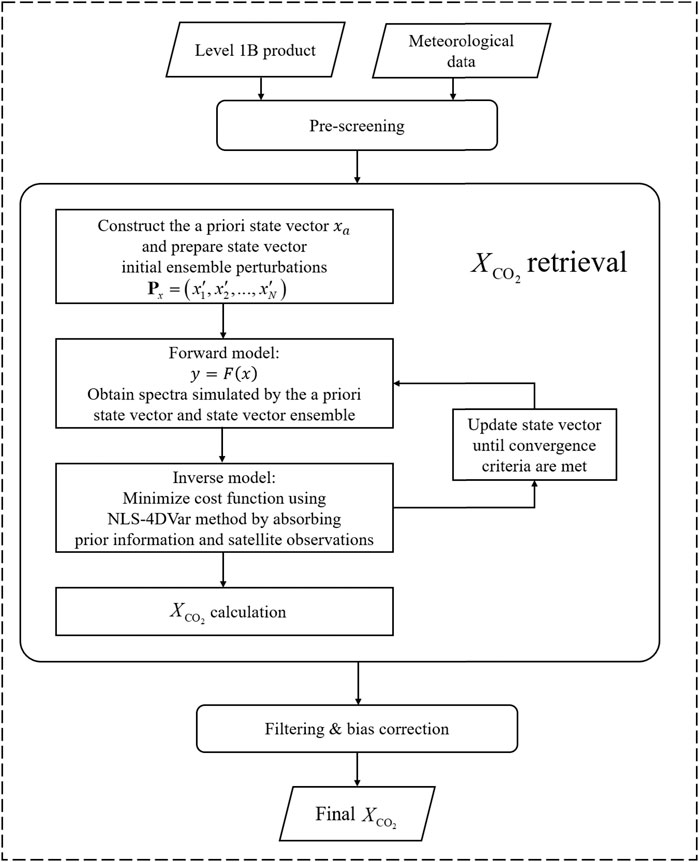An Efficient Algorithm for Retrieving CO2 in the Atmosphere From Hyperspectral Measurements of Satellites: Application of NLS-4DVar Data Assimilation Method
- 1International Center for Climate and Environment Sciences, Institute of Atmospheric Physics, Chinese Academy of Sciences, Beijing, China
- 2College of Earth and Planetary Sciences, University of Chinese Academy of Sciences, Beijing, China
- 3National Tibetan Plateau Data Center, Key Laboratory of Tibetan Environment Changes and Land Surface Processes, Institute of Tibetan Plateau Research, Chinese Academy of Sciences, Beijing, China
- 4Collaborative Innovation Center on Forecast and Evaluation of Meteorological Disasters, Nanjing University of Information Science and Technology, Nanjing, China
- 5Key Laboratory for Middle Atmosphere and Global Environment Observation, Institute of Atmospheric Physics, Chinese Academy of Sciences, Beijing, China
A novel and efficient inverse method, named Nonlinear least squares four-dimensional variational data Assimilation (NLS-4DVar)-based CO2 Retrieval Algorithm (NARA), is proposed for retrieving atmospheric CO2 from the satellite hyperspectral measurements, in which the NLS-4DVar method is used as the optimization method. As the NLS-4DVar method works independently of the tangent linear model and adjoint model, the time-consuming calculation of the weighting function matrix is unnecessary, and the computation complexity is tremendously reduced while maintaining the retrieval accuracy. This is extremely important for space-based CO2 retrievals with large data volumes. Observing system simulation experiments (OSSEs) over four different sites around the world showed that the NARA algorithm could retrieve XCO2 and CO2 profiles effectively. To further evaluate the NARA algorithm, it was used for real CO2 retrievals from target-mode observations of Orbiting Carbon Observatory-2 (OCO-2) over Lamont, Oklahoma, and Darwin, Australia. The results were compared with that of ground measurements of Total Carbon Column Observing Network (TCCON). The mean difference of XCO2 between NARA and TCCON over Lamont, from 180 observations, was −0.15 ppmv with a standard deviation (SD) of 0.76 ppmv. Over Darwin, the mean difference, from 180 observations (90 points over land and 90 points over the ocean), is −0.17 ppmv (SD: 1.26 ppmv). The preliminary results showed that the efficient NLS-4DVar-based algorithm could provide great help for satellite remote sensing of CO2, and it may be used as an operational procedure after further and extensive evaluations.
Introduction
The concentration of CO2 in the atmosphere has continued to increase since the Industrial Revolution, which has had a significant impact on the global climate (Cox et al., 2000; Le Quéré et al., 2016). The formulation of climate policy and control of the future climate require a more accurate and comprehensive understanding of the global carbon cycle (Dilling et al., 2003). Current ground-based and aircraft observations could provide help in modelling and understanding global sources and sinks of CO2 (Wunch et al., 2011); however, the insufficient number and sparse spatial coverage make it difficult to obtain accurate CO2 fluxes on regional scales (Baker et al., 2010; O'Dell et al., 2012).
To acquire CO2 fluxes with high spatial and temporal resolutions to supplement the deficiencies of ground-based and aircraft observations, efforts have been made to retrieve the column-averaged dry air mole fraction of atmospheric CO2 (XCO2) from satellite observations (Rayner and O'Brien, 2001; Miller et al., 2007). Data retrieved from the thermal infrared spectrograph are able to provide good information of CO2 in the mid-troposphere (Chédin et al., 2003; Crevoisier et al., 2009; Kulawik et al., 2010), but the measurements are less sensitive to near surface CO2 variations. Therefore measurements in Near-infrared (NIR)- and short-wave infrared (SWIR)-band are proposed, such as the SCanning Imaging Absorption spectroMeter for Atmospheric CHartographY (SCIAMACHY) (Buchwitz et al., 2005; Reuter et al., 2011), which is a mid-resolution spectrometer. The first dedicated greenhouse gas satellite Greenhouse gases Observing SATellite (GOSAT) and its successor GOSAT-2, with ultra-high spectral resolution in NIR and SWIR bands, were launched into space by Japan Erospace Exploration Agency (JAXA) separately in 2008 (Yokota et al., 2009) and 2018 (Nakajima et al., 2012). Similar specific satellites such as Orbiting Carbon Observatory-2 (OCO-2) (Crisp et al., 2004) and OCO-3 (Eldering et al., 2019) are launched into space separately in 2014 and 2019. China also launched its first satellite, TanSat, for Carbon dioxide measurements in 2016 (Yang et al., 2018). These measurements from space could provide spatial map of atmospheric CO2 and its variation both on regional and global scales (Jiang and Yung, 2019).
A variety of algorithms have been developed for retrievals of CO2 from NIR and SWIR spectra, including the Differential Optical Absorption Spectroscopy (DOAS) approach for SCIAMACHY (Buchwitz et al., 2000; Honninger et al., 2004; Reuter et al., 2010), the National Institute for Environment Studies (NIES) algorithm developed for GOSAT measurements (Yoshida et al., 2011), the Atmospheric CO2 Observations from Space (ACOS) algorithm applied to GOSAT and OCO-2 measurements (Crisp et al., 2012; O'Dell et al., 2012; O'Dell et al., 2018), the University of Leicester Full Physics (UoL-FP) algorithm (Boesch et al., 2011), the RemoTeC algorithm developed by SORN Netherlands Institute for Space Research and Deutsches Zentrum für Luft-und Raumfahrt e.V. (DLR) (Hasekamp and Butz, 2008; Butz et al., 2011; Guerlet et al., 2013) and the ensemble median (EEMA) algorithm (Reuter et al., 2013).
Until now, it is still a challenge to retrieve accurate CO2 concentrations and its vertical profiles from satellite measurements (Yue et al., 2016), some of them can only produce reasonable results under very clear skies. This is due to limitations of parameterization and simplification in the algorithm, i.e., first guess of CO2 profile, atmospheric parameters and their vertical distributions, and simplification of the weighting function matrix calculation owing to time-consuming burden. In this paper, a novel algorithm, NLS-4DVar-based CO2 Retrieval Algorithm (NARA), is proposed. The NLS-4DVar method rewrites the cost function as a nonlinear least squares problem and solves it iteratively using the Gauss-Newton method. In the iterative process, the a priori covariance matrix is not a fixed one but constantly updated. Moreover, the calculations of the weighting function matrix and its transposition are avoided through simple mathematical transformations, which greatly reduces programming difficulty and computational complexity while maintaining the retrieval accuracy. This is particularly important for space-based CO2 retrievals considering the huge number of satellite measurements.
The rest of this article is organized as follows. Sect. 2 introduces the NARA algorithm in detail, including the forward and inverse models. Sect. 3 evaluates the NARA algorithm in terms of XCO2 and the CO2 profile through observing system simulation experiments (OSSEs). Sect. 4 describes real-data retrievals using OCO-2 observations and comparisons between NARA retrieved XCO2 and coincident TCCON measurements. Finally, Sect. 5 discusses and concludes the paper.
Description of the NLS-4DVar-based CO2 Retrieval Algorithm
The NARA retrieval algorithm obtains the optimal state vector under the joint constraints of satellite measurements and prior information. The state vector contains the CO2 profile and several parameters to which the spectra are sensitive. The optimal column-averaged CO2 is calculated according to the CO2 profile. The NARA algorithm can be applied to any greenhouse gas satellites, but requires some specific modifications according to the satellite instruments. At present, we use information and observations from OCO-2 satellite to make preliminary evaluations of the NARA algorithm. The OCO-2 observations of the reflected sunlight spectra in three bands: O2 A band at 0.76 µm, weak CO2 band at 1.61 µm, and strong CO2 band at 2.06 µm are used for retrievals (O'Dell et al., 2018). NARA algorithm include data preparation, XCO2 retrieval and bias correction. A flow chart of the NARA algorithm is shown in Figure 1.
1. Data Input and Pre-screening
The input data of the algorithm include the Level 1B product of satellite measurements and meteorological data interpolated to the observation points. The Level 1B product includes the calibrated radiances for three spectral bands and geolocation information. The pixels with low signal-to-noise ratio and those contaminated by clouds and aerosols are filtered out (Taylor et al., 2016). The meteorological data include surface pressure, water vapor profile, temperature profile, and surface wind speed, which are from gridded GEOS5-FP-IT (Goddard Earth Observing System, Version 5, Forward Processing for Instrument Teams) reanalysis and interpolated to the observation location.
2. XCO2 Retrieval
The XCO2 retrieval is the core of the algorithm. XCO2 is the column-averaged dry air mole fraction of atmospheric CO2, and the unit is part per million (ppm). The a priori state vector from the input data, as well as the initial ensemble of the state vector, are constructed. They are then input into the forward model to obtain simulated spectra. This information and satellite observations are input into the inverse model, and the optimal estimate of the state vector is obtained through the NLS-4DVar method. XCO2 is then calculated according to the CO2 profile in the state vector.
3. Bias Correction
Currently all space-borne XCO2 retrievals have systematic biases, mainly due to uncertainty in spectroscopy, limitations in the information provided by the observations, imperfect modelling of the atmosphere and surface, as well as uncertainty in instruments. Therefore, bias correction is necessary for the retrieved XCO2 (Schneising et al., 2012; Guerlet et al., 2013; Crisp et al., 2017). The bias correction procedure of NARA algorithm adopted from OCO-2 consists of three main parts: first, correct the parametric biases that is caused by the spurious correlation of the retrieved XCO2 with other retrieval parameters; second, correct the footprint-dependent biases that are truly instrument-related; finally, apply a global scaling to remove the remaining biases (O'Dell et al., 2018).
Forward Model
The parameters to be optimized in the forward model constitute the state vector
where
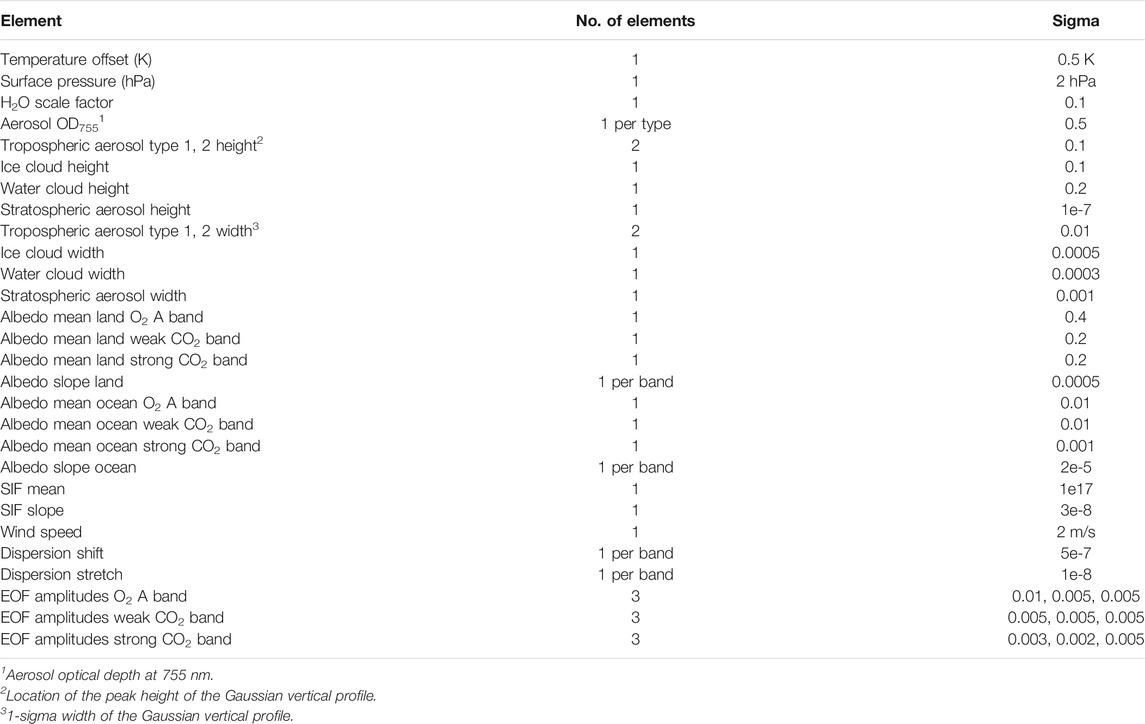
TABLE 1. Standard deviations of normal distributions when generating ensembles of initial perturbations for parameters in the state vector excluding the CO2 profile.
The prior value of the state vector is calculated by the ACOS algorithm (O'Dell et al., 2012; O'Dell et al., 2018). The vertical coordinate uses a simple sigma coordinate system, that is
Inverse Model
The inverse model is used to obtain the minimum value of the following cost function through the optimization algorithm:
where
NLS-4DVar Method
The NLS-4DVar method (Tian and Feng, 2015; Tian et al., 2018) rewrites the cost function in Eq. 2 into an incremental format to determine the analysis increment for the a priori state vector:
where
where
Obviously, Eq. 7 can be solved iteratively by computing the cost function and its gradient:
where
To circumvent the calculation of the weighting function matrix and its transposition, the NLS-4DVar method converts Eq. 7 into the following nonlinear least squares problem:
Here
where
where
According to Tian et al. (2018), the cost function generally reaches the minimum convergence standard after three iterations. Here the optimal state vector contains the CO2 profile component, allowing the calculation of the best estimation of XCO2.
Initial Ensemble Generation
As mentioned above, the NLS-4DVar method assumes that the analysis increment can be expressed as the linear combination of the initial perturbations; the quality of the initial ensemble of perturbations is vital to the success of the retrieval. For different components in the state vector, we use different initial ensemble generation methods. The CO2 profile ensemble of perturbations is generated by the random state variable (RSV) method (Zhang, 2019), the ensembles of the other components are generated by normal distributions.
The RSV method first requires a big ensemble of perturbations. The method then performs singular value decomposition and the random orthogonal matrix to obtain the final small ensemble (Evensen, 2009). The big ensemble comes from the model simulated CO2 of GEOS-Chem (v11-01; http://acmg.seas.harvard.edu/geos/). There are seven carbon fluxes used to drive GEOS-Chem: fossil fuel emissions, ocean carbon fluxes, terrestrial ecosystem fluxes, biomass burning emissions, ships emissions, aviation emissions, and chemical oxidation production. The ocean carbon fluxes and terrestrial ecosystem fluxes are optimized by the Tan-Tracker flux inversion system (Tian et al., 2014a; Tian et al., 2014b) through assimilating OCO-2 XCO2 retrievals. GEOS-Chem simulates the CO2 profile at 47 atmospheric pressure levels, with a horizontal resolution of 2° latitude × 2.5° longitude. The 47 pressure levels are defined using the hybrid sigma-pressure grid, and the top atmospheric pressure level is about 0.038 hPa (http://wiki.seas.harvard.edu/geos-chem/index.php/GEOS-Chem_vertical_grids#Hybrid_grid_definition, last access: June 3, 2021). In order to avoid the size of big ensemble being too large, the CO2 profile is taken every 4 grid points along the longitude and the daily average CO2 profile is computed. The profile is then interpolated to the 20 pressure levels, where the CO2 profile in the NARA algorithm is located. According to the month and latitude of the satellite measurement, the model data of the two latitude bands above and below the measurement latitude during an entire month are selected as the big ensemble. For example, consider the measurement at 36.641° N and 97.441° W on January 30, 2016. The simulation results of GEOS-Chem at 36.0° N and 38.0° N in January 2016 show a total of
where
Here
The initial ensembles of the other parameters in the state vector are the random perturbations of normal distributions; that is, the mean of the normal distribution takes the prior value. The standard deviations (Table 1) were obtained by sensitivity experiments and analysing OCO-2 data. The initial ensemble of the state vector is constructed by combining the CO2 profile ensemble and the remaining parameter ensembles together. Add the a priori state vector to the ensemble and input it into the forward model to obtain the simulated spectra. After preparing the above data, we can determine the optimal estimate of XCO2 using the NLS-4DVar method introduced in Sect. 2.2.1.
Observing System Simulation Experiments for Evaluating the (NLS-4DVar)-based CO2 Retrieval Algorithm
In this section, we evaluated the NARA algorithm comprehensively by performing observing system simulation experiments (OSSEs) at four different sites around the world. Besides, we conducted a set of experiments at one site, discussing the effects of aerosol amounts on XCO2 retrievals.
Experimental Setup
A total of four sites around the world were selected for retrievals. Three were near Total Carbon Column Observing Network (TCCON) (Wunch et al., 2011) stations, specifically the Lamont (LA), Bremen (BR), and Wollongong (WO) stations, and the remaining one was on the North Pacific (OC). Information on these four sites is listed in Table 2, and their specific locations are shown in Figure 2. The impacts of surface properties, latitudes, seasons, and land–sea distribution on retrievals were carefully considered when selecting the retrieval sites to ensure the comprehensiveness of the experiments. Especially, previous studies have indicated that scenes without aerosol contamination could yield better results, and XCO2 retrieval biases appeared to be correlated with scattering by aerosols (Wunch et al., 2017; O'Dell et al., 2018). Thus, we performed a set of OSSEs at the Lamont station to evaluate retrieval results under different aerosol amounts.

TABLE 2. Information on the four retrieval sites in the OSSEs, including the observation date, sounding ID, location (listed in degrees latitude and degrees longitude), and surface properties. (LA: Lamont; BR: Bremen; WO: Wollongong; OC: the ocean site).
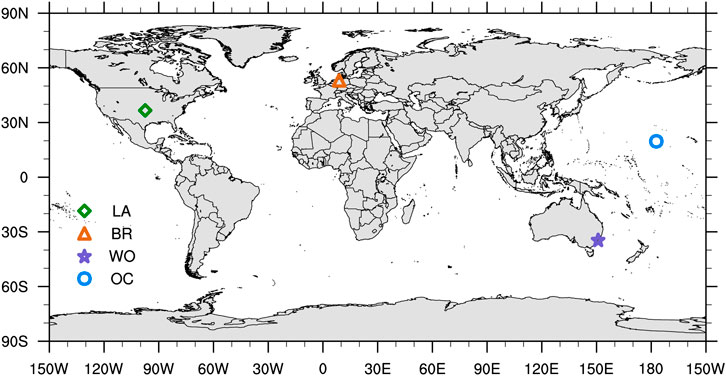
FIGURE 2. Map of the four retrieval sites in OSSEs. (LA, Lamont; BR, Bremen; WO, Wollongong; OC, the ocean site).
We used OCO-2 version eight retrospective (i.e., 8r) data in the OSSEs, including Level 1B data OCO2_L1B_Calibration 8r, meteorological data OCO2_L2_Met 8r, pre-screening data OCO2_L2_ABand 8r, and OCO2_IMAPDOAS 8r, as well as diagnostic data OCO2_L2_Diagnostic 8r (https://disc.gsfc.nasa.gov/datasets?keywords=oco2&sort=processLevel&page=1). The pre-screening procedure uses ABO2 and IMAP-DOAS pre-processors to remove scenes contaminated by clouds or aerosols (Taylor et al., 2016). The diagnostic data provide prior and retrieved state vectors and prior XCO2 in the OSSEs. We used target-mode data for the three retrieval sites over land and glint-mode data for the retrieval site over the ocean. We generated the initial ensemble following the method introduced in Sect. 2.2.2, and we chose 50 for the size of the ensemble after sensitivity experiments.
In OSSEs, the a priori state vector adopts the a priori value calculated by OCO-2 according to the input data, and the constructed true state vector adopts the OCO-2 retrieval result of the observation point or a nearby point. The constructed true state vector is input into the forward model to obtain the simulated spectra. The observation error of OCO-2 is then added to the simulated spectra to obtain the observation spectra. The a priori CO2 profile and constructed true CO2 profile are shown in Figure 6. The spectra simulated by the a priori state vector and constructed observation spectra are shown in Figure 3. For the aerosol specific evaluation, we conducted a set of OSSEs at the Lamont station on January 3, 2016 under three different tropospheric aerosol amounts. The two tropospheric aerosol types were sulfate and organic carbon. As the values of
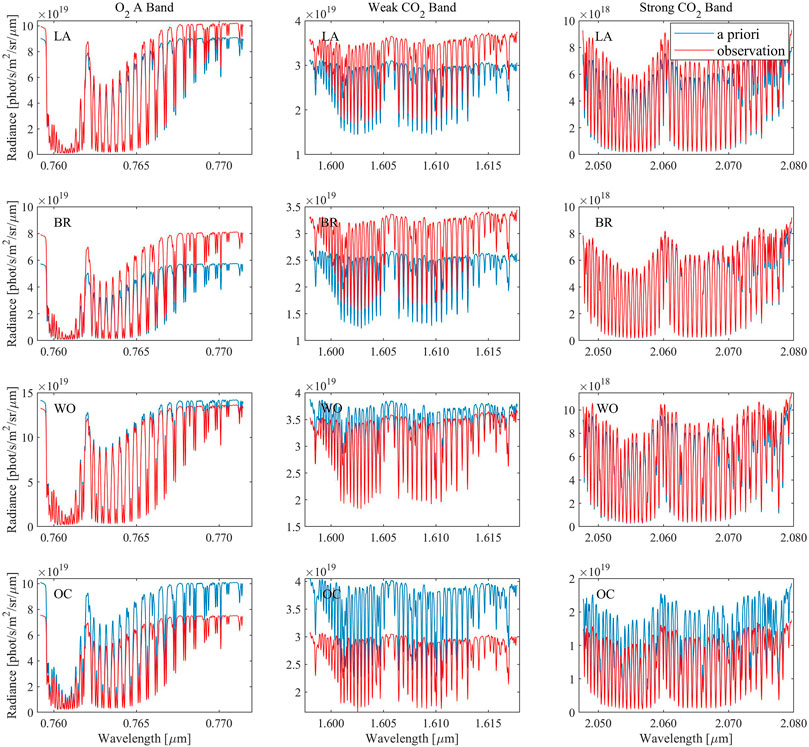
FIGURE 3. Spectra simulated by the a priori state vector and constructed observation spectra in three bands. The first column is the O2 A band, the second column is the weak CO2 band, and the third column is the strong CO2 band. The first to fourth rows are the spectra at LA, BR, WO, and OC, respectively. The name of the observation point is in the upper left corner of each subplot.
Experimental Results
The retrieval quality was evaluated in terms of the XCO2 and CO2 profiles. XCO2 is the product currently provided by satellite retrievals, and accurate CO2 profiles are the goals of retrieval algorithms.
XCO2 Results
The differences between the a priori XCO2 and the true XCO2 were relatively large; specifically, LA, BR, WO, and OC showed differences of 1.88, 1.70, –3.15, and 2.27 ppm, respectively. Figure 4 shows the XCO2 obtained by the NARA algorithm after one, two, and three iterations and comparisons with the a priori XCO2 and the true XCO2 at the four retrieval sites. The retrieved XCO2 gradually approached the true value as the iterations of the NARA algorithm progressed, ultimately reaching the optimal value at the third iteration. The differences between the NARA retrieved XCO2 and the true XCO2 after three iterations were 0.33, 0.11, 0.11, and –1.13 ppm at LA, BR, WO, and OC, respectively, which was a big improvement from the prior XCO2 and showed that our algorithm was effective.
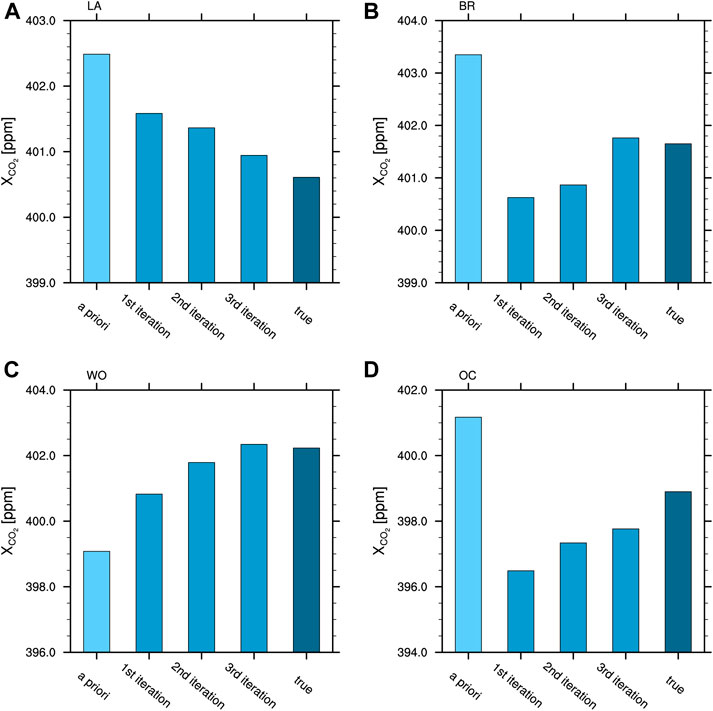
FIGURE 4. NARA retrieved XCO2 after one, two, and three iterations and comparisons with the a prioriXCO2 and the true XCO2 at (A) LA, (B) BR, (C) WO, and (D) OC.
The retrievals at LA and WO were similar. At these two sites, the retrieval of the first iteration was very effective, with subsequent iterations approaching the true value. After three iterations, the NARA retrieved XCO2 was quite close to the true XCO2. The results for BR and OC were similar. The retrieval of the first iteration was significantly changed compared with the prior value, which showed that observation information had a huge impact on retrieval. In subsequent iterations at BR and OC, under the mutual constraints of the prior information and observations, the retrieved XCO2 gradually approached the true value and reached the optimal XCO2 at the third iteration. The NARA retrieved XCO2 of the three retrieval sites over land were closer to the true XCO2 than the NARA retrieved XCO2 at the ocean site OC, which was attributable to the different observation modes and surface properties over land and ocean and/or the varying accuracies of the prior values.
The NARA retrieved XCO2 depended on atmospheric AODs (Figure 5A). The prior and true XCO2 at the observation site were 402.49 ppm and 400.61 ppm. The NARA retrieved XCO2 for scenario 1 (S1), scenario 2 (S2), and scenario 3 (S3) were 400.94, 401.13, and 401.24 ppm, respectively. S1 had the highest AOD while S3 had the lowest AOD. It’s clear that as the AOD decreased, the bias of retrieved XCO2 increased, which indicated that more accurate XCO2 can be retrieved under atmospheric conditions with less aerosols.
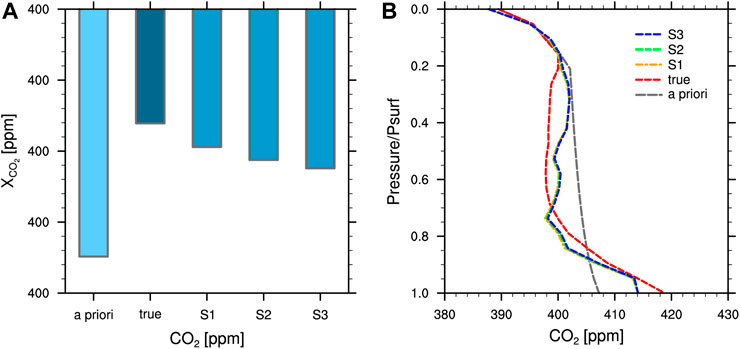
FIGURE 5. The prior and true values as well as NARA retrievals with different atmospheric AODs. (A) depicts the CO2 profiles, and (B) depicts the XCO2. S1, S2, and S3 indicates scenario 1, scenario 2, and scenario 3, respectively.
CO2 Profile Results
Figure 6 shows the CO2 profiles obtained by the NARA algorithm after one, two, and three iterations and comparisons with the a priori CO2 profile and the true CO2 profile at the four retrieval sites. The CO2 profiles differed between the Northern and Southern hemispheres. The vertical gradient of the CO2 profile in the Northern Hemisphere was larger than in the Southern Hemisphere, which is depicted in Figure 6.
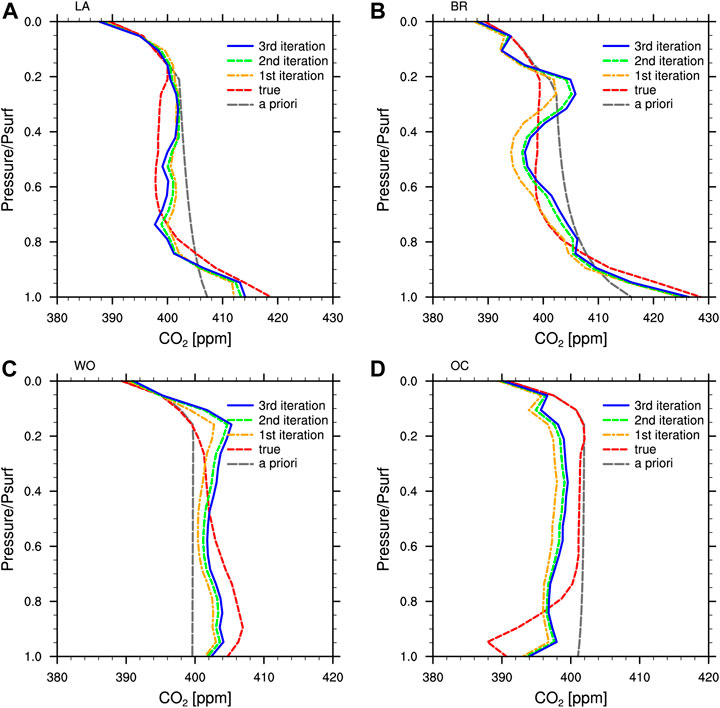
FIGURE 6. NARA retrieved CO2 profiles after one, two, and three iterations and comparisons with a priori and true CO2 profiles at (A) LA, (B) BR, (C) WO, and (D) OC.
First look at the retrieval results for the two Northern Hemisphere sites LA and BR. The vertical gradient of the a priori CO2 profile was relatively small. The true CO2 profile above the troposphere was in good agreement with the a priori CO2 profile; however, the vertical gradient in the troposphere was greater than that of the a priori profile. As the iterations progressed, the NARA retrieved CO2 profile gradually approached the true value. After three iterations, the NARA retrieved CO2 profile was very close to the true profile, in particular in the lower troposphere. This is particularly important given that the carbon sources and sinks of interest are all located in the lower troposphere. A close look at the retrieval results for the two Southern Hemisphere sites WO and OC shows that the vertical gradient of the a priori CO2 profile in the troposphere was quite small. The NARA retrieved CO2 profiles roughly grasped the characteristics of the true profiles; however, they were unable to well simulate the relatively large vertical gradient of the true profile in the lower troposphere, which were not as good as the results for the Northern Hemisphere. Because the vertical gradient of the a priori CO2 profile in the Southern Hemisphere was small, the vertical gradient of the CO2 profile ensemble decomposed on the basis of the prior value was also small. The analysis increment was a linear combination of the ensemble members, thus it could not retrieve well a large vertical gradient as the true profile indicated. This problem may be solved by providing a better prior CO2 profile. The retrieved CO2 profile can also be influenced by aerosol contents (Figure 5B). The patterns of the CO2 profile under different AODs were similar, but the specific CO2 concentrations at each level were various, which contributed to the discrepancy of the column-averaged value. The above analyses demonstrate that the NARA retrieved CO2 profiles in the Northern Hemisphere were relatively accurate, in particular in the lower troposphere. The retrieval results for the Southern Hemisphere roughly grasped the characteristics of the true profiles but still needed more improvement. The effects of aerosol scattering should also be considered during the retrievals.
Real-Data Retrievals and Comparisons With Total Carbon Column Observing Network Data
In this section, we evaluated the XCO2 retrieved by the NARA algorithm using OCO-2 version 8r target-mode observations at two target locations and compared the NARA retrieved XCO2 with coincident TCCON data. TCCON is a global network of ground-based instruments that can retrieve accurate and precise XCO2, which provides an essential validation resource for space-based measurements (Wunch et al., 2011). In addition, we performed real retrievals using the normal 4DVar method, which requires the calculation of the pressure weighting function and its transposition, and compared the retrievals with NARA retrieved ones.
Experimental Setup
Target mode is designed to evaluate biases in the OCO-2 XCO2 product, whose strength is that thousands of spectra can be obtained in a short period of time over a small region (about 0.2° latitude × 0.2° longitude for the densest measurements) (Wunch et al., 2017). The target locations are mostly selected to be coincident with ground-based stations, typically at TCCON sites (Wunch et al., 2011). Given the differences between the Northern and Southern hemispheres, the two target locations selected for validation were Lamont, Oklahoma, in the central United States and Darwin, Australia, on the northern coast. The Lamont location has relatively uniform surface properties and is reasonably far from anthropogenic CO2 sources, and the ground cover changes with the seasons (Wunch et al., 2017); in contrast, target-mode measurements at the Darwin location contain observations over both land and ocean. Information on these two target locations is shown in Table 3. OCO-2 measurements over about 1 year were selected for validation at each of the two locations. The observation dates are listed in Table 4.

TABLE 3. Information on the two validated target locations for real retrievals. The target location is listed in degrees latitude, degrees longitude, and altitude above sea level in km.

TABLE 4. Dates of the target-mode observations selected for real retrievals at the two validated target locations.
Restricted by our computational resources, we randomly selected 10 observation points from OCO-2 pre-screened measurements for retrievals each day at the Lamont location; for the Darwin location, we randomly selected 10 observation points over land and 10 observation points over the ocean each day. For the 4DVar retrievals, we performed experiments at the Lamont station on November 24, 2014. We retrieved XCO2 at the same 10 observation points and used the same prior values as the NARA algorithm. We assumed that TCCON data were coincident with OCO-2 target-mode measurements when they were recorded within ±30 min of the target-mode maneuver. If there were fewer than five TCCON measurements within that time frame, the period was extended to ±120 min. Then we compared the median of the NARA retrieved XCO2 of the 10 selected observation points with the median of coincident TCCON measurements. In the real retrievals, the size of the initial ensemble was 50, and the number of iterations was three. Then we corrected the NARA retrieved XCO2 for bias using the OCO-2 bias correction method (O'Dell et al., 2018).
Experimental Results
Figure 7 shows the median of the NARA retrieved XCO2 and comparisons with the median of the OCO-2 retrieved XCO2 using the ACOS algorithm for the same observation points and the median of the coincident TCCON measurements at Lamont and Darwin locations. Retrievals over the land and ocean at the Darwin location were evaluated separately because land and ocean surface reflections were modelled differently as purely Lambertian over land and Cox–Munk with a Lambertian component over water (O'Dell et al., 2018). The XCO2 retrieved by the NARA algorithm and OCO-2 were generally smaller than TCCON data, in particular over land. It is common for OCO-2 that a retrieved XCO2 will be smaller than TCCON data. The NARA algorithm uses similar state vector setting and aerosol characterization as the ACOS algorithm; thus, some features of NARA retrievals are similar to OCO-2 results. This problem may be mitigated by fitting an intensity offset for all three bands and improving aerosol treatments (Wu et al., 2018).
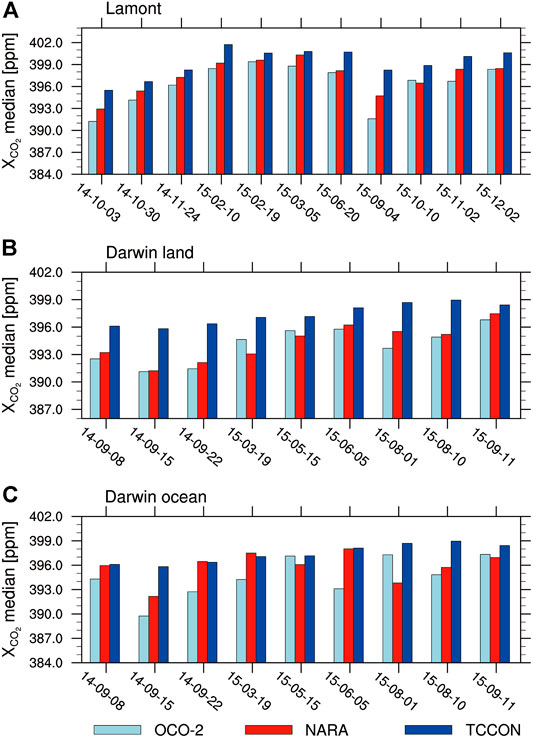
FIGURE 7. The median of the NARA retrieved XCO2 and comparisons with median of the OCO-2 retrieved XCO2 for the same observation points and the median of the coincident TCCON data at (A) the Lamont location, (B) the Darwin location over land, and (C) the Darwin location over the ocean.
To better evaluate the retrieval quality, we defined the bias (

TABLE 5. Bias (
Define the daily standard deviation (
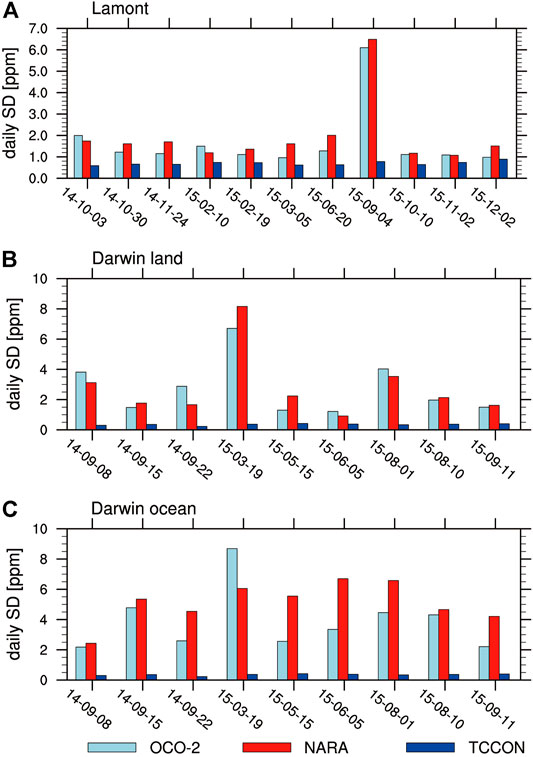
FIGURE 8. Daily standard deviation (σd) of the NARA retrieved XCO2 and comparisons with σd of the OCO-2 retrieved XCO2 for the same observation points and σd of the coincident TCCON data at (A) the Lamont location, (B) the Darwin location over land, and (C) the Darwin location over the ocean.
For the further contrast between different optimization methods, the medians and standard deviations of retrievals from 4DVar, NARA, OCO-2, and TCCON at the Lamont station on November 24, 2014 were compared. Without bias correction, the medians of XCO2 from 4DVar, NARA, OCO-2, and TCCON were 403.28, 397.25, 396.19, and 398.26 ppm, respectively. The corresponding standard deviations were 8.85, 1.70, 1.15, and 0.65 ppm, respectively. The 4DVar retrieved XCO2 was much higher than TCCON estimate, and the standard deviation was also bigger than other methods. The NARA median XCO2 was closest to the TCCON median, and OCO-2 retrievals had the smallest standard deviation. We additionally compared the computational time consumed by each method. The retrieval time of one iteration (excluding forward simulation) from the NARA algorithm was about 0.2–0.3 s. The retrieval time of one iteration for the 4DVar method varied under different circumstances, but most exceeded 1 s. The retrieval time of OCO-2 was close to the 4DVar method.
Figure 9 shows the variation over time in NARA retrieved XCO2 and coincident TCCON measurements at the Lamont and Darwin locations. As can be seen from the results for the Lamont location, the NARA retrievals captured well the seasonal variation in XCO2. In addition, the retrieval results improved greatly after bias correction. After bias correction, the bias (
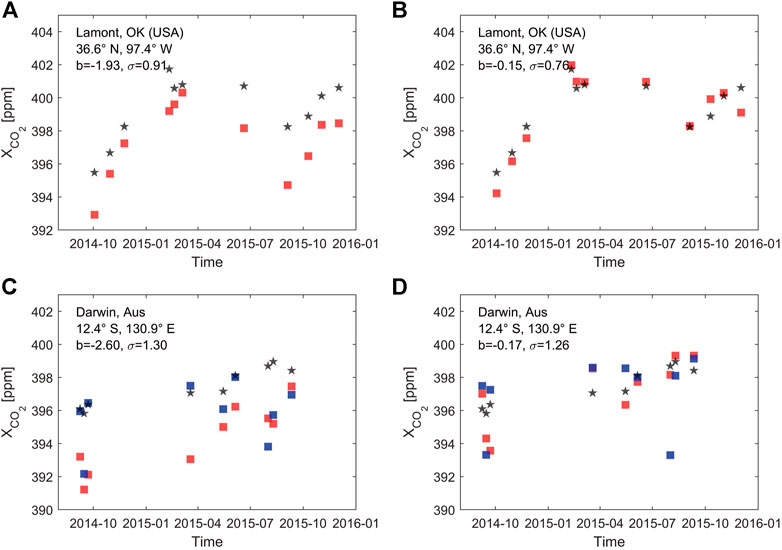
FIGURE 9. Variation over time in NARA retrieved XCO2 over land (red squares) and ocean (blue squares) and coincident TCCON measurements (black stars) at the Lamont and Darwin locations. The NARA retrievals in (A) and (C) are before bias correction, and those in (B) and (D) are bias-corrected. In each subplot, the site location in latitude and longitude, bias (B) and sounding precision (σ) are presented. The units for b and σ are ppm.
Figure 10 shows the relationship between the median of NARA target-mode retrievals and the median of coincident TCCON data. The best fit straight lines were computed in a least squares sense. Figure 10A shows the relationship prior to bias correction and had a correlation coefficient of
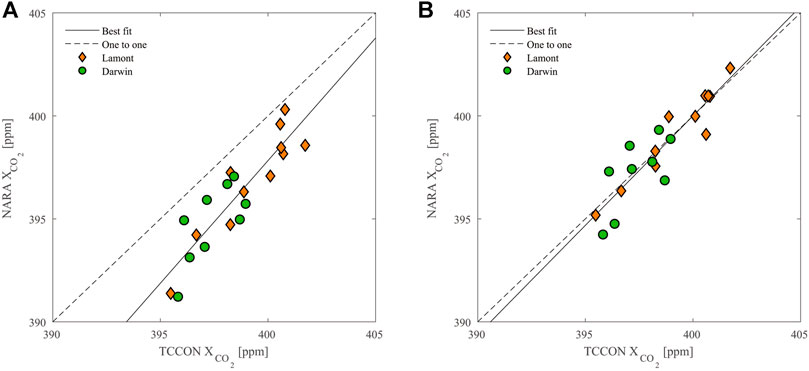
FIGURE 10. Relationships between the median of NARA target-mode retrievals and the median of coincident TCCON data. (A) Data before bias correction. (B) Data after bias correction. A one-to-one line is indicated by the dashed line, and the best fit line is indicated by the solid line.
Summary and Discussion
In this study, we developed a novel CO2 retrieval algorithm, NARA, which used the NLS-4DVar method as the optimization method, and adopted the LIDORT radiative transfer model and necessary parameters provided by the ACOS algorithm in the forward model. The advantages of the NARA algorithm are its simplicity and efficiency given the NLS-4DVar method as its basis, as there is no need to calculate the weighting function matrix and its transposition during the retrieval process. This greatly reduces computational complexity while maintaining retrieval accuracy, which is extremely important for satellite retrievals whose data volume is quite huge.
OSSEs and real-data retrievals were carefully designed to evaluate the NARA algorithm. The OSSEs showed that the NARA retrievals of both XCO2 and the CO2 profile were greatly improved compared to prior values and were close to the true values. In particular, the retrieved CO2 profiles of the two sites in the Northern Hemisphere over land captured well the real situation in the lower troposphere, where CO2 sources and sinks are located. The effect of aerosol concentrations on XCO2 retrieval was also discussed. We performed a set of three OSSEs with different AODs, and the results indicated that the retrieved XCO2 was more accurate with lower aerosol concentrations. Then we performed real-data retrievals using OCO-2 target-mode observations and compared the NARA retrieved XCO2 with coincident TCCON measurements at the Lamont and Darwin locations. Before bias correction, the mean difference between the NARA retrieved XCO2 and coincident TCCON measurements was –1.93 ppm (SD: 0.91 ppm) at the Lamont location; the mean difference was –2.60 ppm (SD: 1.30 ppm) at the Darwin location. These results were not inferior to the OCO-2 retrieval results for the corresponding observation points. We also compared the XCO2 retrievals with the normal 4DVar method. The retrieval bias and standard deviation of 4DVar method were bigger than NARA and OCO-2 results. Besides, the computational time consumed by one iteration from NARA was the least.
At present, the NARA algorithm is demonstrated effective, but still needs further improvements. The daily standard deviations of NARA XCO2 retrievals were relatively large, especially over the ocean. In future work, we intend to further optimize the NARA algorithm, such as improving the prior state vector and generation of the initial ensemble, to enhance its robustness. Moreover, the algorithm was tested at several TCCON stations, next it will be tested through all TCCON stations to evaluate the retrieval results of target-, nadir-, and glint-mode observations. In addition, we plan to construct and incorporate data filtering and bias correction components customized to the NARA algorithm, and make the algorithm become an operation procedure to produce mature XCO2 products.
Data Availability Statement
The raw data supporting the conclusions of this article will be made available by the authors, without undue reservation.
Author Contributions
ZJ: Software, Validation, Formal analysis, Investigation, Data Curation, Writing-Original Draft, Visualization XT: Conceptualization, Methodology, Resources, Writing-Review and Editing, Supervision, Funding acquisition DM: Methodology, Writing-Review and Editing, Supervision HR: Software, Investigation, Writing-Review and Editing.
Funding
This work was supported by the National Key Research and Development Program of China (2016YFA0600203), the National Natural Science Foundation of China (41575100), and the Key Research Program of Frontier Sciences, Chinese Academy of Sciences (CAS) (QYZDYSSW-DQC012).
Conflict of Interest
The authors declare that the research was conducted in the absence of any commercial or financial relationships that could be construed as a potential conflict of interest.
References
Baker, D. F., Bösch, H., Doney, S. C., O'Brien, D., and Schimel, D. S. (2010). Carbon Source/sink Information provided by Column CO2 Measurements from the Orbiting Carbon Observatory. Atmos. Chem. Phys. 10 (9), 4145–4165. doi:10.5194/acp-10-4145-2010
Boesch, H., Baker, D., Connor, B., Crisp, D., and Miller, C. (2011). Global Characterization of CO2 Column Retrievals from Shortwave-Infrared Satellite Observations of the Orbiting Carbon Observatory-2 Mission. Remote Sensing. 3 (2), 270-304. doi:10.3390/rs3020270
Buchwitz, M., de Beek, R., Noël, S., Burrows, J. P., Bovensmann, H., Bremer, H., et al. (2005). Carbon Monoxide, Methane and Carbon Dioxide Columns Retrieved from SCIAMACHY by WFM-DOAS: Year 2003 Initial Data Set. Atmos. Chem. Phys. 5 (12), 3313-3329. doi:10.5194/acp-5-3313-2005
Buchwitz, M., Rozanov, V. V., and Burrows, J. P. (2000). A Near-Infrared Optimized DOAS Method for the Fast Global Retrieval of Atmospheric CH4, CO, CO2, H2O, and N2O Total Column Amounts from SCIAMACHY Envisat-1 Nadir Radiances. J. Geophys. Res. 105 (D12), 15231-15245. doi:10.1029/2000jd900191
Butz, A., Galli, A., Hasekamp, O., Landgraf, J., Tol, P., and Aben, I. (2012). TROPOMI Aboard Sentinel-5 Precursor: Prospective Performance of CH4 Retrievals for Aerosol and Cirrus Loaded Atmospheres. Remote Sensing Environ. 120, 267-276. doi:10.1016/j.rse.2011.05.030
Butz, A., Guerlet, S., Hasekamp, O., Schepers, D., Galli, A., Aben, I., et al. (2011). Toward Accurate CO2 and CH4 observations from GOSAT. Geophys. Res. Lett. 38 (14), a-n. doi:10.1029/2011gl047888
Butz, A., Hasekamp, O. P., Frankenberg, C., and Aben, I. (2009). Retrievals of Atmospheric CO2 from Simulated Space-Borne Measurements of Backscattered Near-Infrared Sunlight: Accounting for Aerosol Effects. Appl. Opt. 48 (18), 3322-3336. doi:10.1364/ao.48.003322
Chédin, A., Serrar, S., Scott, N. A., Crevoisier, C., and Armante, R. (2003). First Global Measurement of Midtropospheric CO2 from NOAA Polar Satellites: Tropical Zone. J. Geophys. Res. 108 (D18), 4581. doi:10.1029/2003jd003439
Cogan, A. J., Boesch, H., Parker, R. J., Feng, L., Palmer, P. I., Blavier, J.-F. L., et al. (2012). Atmospheric Carbon Dioxide Retrieved from the Greenhouse Gases Observing SATellite (GOSAT): Comparison with Ground-Based TCCON Observations and GEOS-Chem Model Calculations. J. Geophys. Res. 117 (21), a-n. doi:10.1029/2012jd018087
Connor, B. J., Boesch, H., Toon, G., Sen, B., Miller, C., and Crisp, D. (2008). Orbiting Carbon Observatory: Inverse Method and Prospective Error Analysis. J. Geophys. Res. 113 (D5), a-n. doi:10.1029/2006jd008336
Cox, P. M., Betts, R. A., Jones, C. D., Spall, S. A., and Totterdell, I. J. (2000). Acceleration of Global Warming Due to Carbon-Cycle Feedbacks in a Coupled Climate Model. Nature. 408 (6809), 184-187. doi:10.1038/35041539
Crevoisier, C., Chédin, A., Matsueda, H., Machida, T., Armante, R., and Scott, N. A. (2009). First Year of Upper Tropospheric Integrated Content of CO2 from IASI Hyperspectral Infrared Observations. Atmos. Chem. Phys. 9 (14), 4797-4810. doi:10.5194/acp-9-4797-2009
Crisp, D., Atlas, R. M., Breon, F.-M., Brown, L. R., Burrows, J. P., Ciais, P., et al. (2004). The Orbiting Carbon Observatory (OCO) mission. Adv. Space Res. 34 (4), 700-709. doi:10.1016/j.asr.2003.08.062
Crisp, D., Fisher, B. M., O'Dell, C., Frankenberg, C., Basilio, R., Bösch, H., et al. (2012). The ACOS CO2 Retrieval Algorithm - Part II: Global XCO2 Data Characterization. Atmos. Meas. Tech. 5 (4), 687-707. doi:10.5194/amt-5-687-2012
Crisp, D., Pollock, H. R., Rosenberg, R., Chapsky, L., Lee, R. A. M., Oyafuso, F. A., et al. (2017). The On-Orbit Performance of the Orbiting Carbon Observatory-2 (OCO-2) Instrument and its Radiometrically Calibrated Products. Atmos. Meas. Tech. 10 (1), 59–81. doi:10.5194/amt-10-59-2017
Dennis, J. E., and Schnabel, R. B. (1996). Numerical Methods for Unconstrained Optimization and Nonlinear Equations. Philadelphia, PA, USA: Society for Industrial and Applied Mathematics. doi:10.1137/1.9781611971200
Dilling, L., Doney, S. C., Edmonds, J., Gurney, K. R., Harriss, R., Schimel, D., et al. (2003). Therole Ofcarboncycleobservations Andknowledge Incarbonmanagement. Annu. Rev. Environ. Resour. 28, 521-558. doi:10.1146/annurev.energy.28.011503.163443
Eldering, A., Taylor, T. E., O'Dell, C. W., and Pavlick, R. (2019). The OCO-3 mission: Measurement Objectives and Expected Performance Based on 1 Year of Simulated Data. Atmos. Meas. Tech. 12 (4), 2341–2370. doi:10.5194/amt-12-2341-2019
Evensen, G. (2009). Data Assimilation: The Ensemble Kalman Filter. Berlin Heidelberg: Springer-Verlag. doi:10.1007/978-3-642-03711-5
Griffith, D. W. T., Deutscher, N. M., Velazco, V. A., Wennberg, P. O., Yavin, Y., Keppel-Aleks, G., et al. (2014). TCCON Data from Darwin (AU). Anmeyondo, South Korea, Release GGG2014R0, TCCON data archive: CaltechDATA
Guerlet, S., Butz, A., Schepers, D., Basu, S., Hasekamp, O. P., Kuze, A., et al. (2013). Impact of Aerosol and Thin Cirrus on Retrieving and Validating XCO2 from GOSAT Shortwave Infrared Measurements. J. Geophys. Res. Atmos. 118 (10), 4887-4905. doi:10.1002/jgrd.50332
Han, R., and Tian, X. (2019). A Dual-Pass Carbon Cycle Data Assimilation System to Estimate Surface CO2 Fluxes and 3D Atmospheric CO2 Concentrations from Spaceborne Measurements of Atmospheric CO2. Geoscientific Model. Develop. Discussion Rev. doi:10.5194/gmd-2019-54
Hasekamp, O. P., and Butz, A. (2008). Efficient Calculation of Intensity and Polarization Spectra in Vertically Inhomogeneous Scattering and Absorbing Atmospheres. J. Geophys. Res. 113 (D20), D20309. doi:10.1029/2008JD010379
Hoinka, K. P. (1998). Statistics of the Global Tropopause Pressure. Mon. Wea. Rev. 126, 3303-3325. doi:10.1175/1520-0493(1998)126<3303:SOTGTP>2.0.CO;2
Hönninger, G., von Friedeburg, C., and Platt, U. (2004). Multi axis Differential Optical Absorption Spectroscopy (MAX-DOAS). Atmos. Chem. Phys. 4, 231-254. doi:10.5194/acp-4-231-2004
Jiang, X., and Yung, Y. L. (2019). Global Patterns of Carbon Dioxide Variability from Satellite Observations. Annu. Rev. Earth Planet. Sci. 47, 225-245. doi:10.1146/annurev-earth-053018-060447
Kulawik, S. S., Jones, D. B. A., Nassar, R., Irion, F. W., Worden, J. R., Bowman, K. W., et al. (2010). Characterization of Tropospheric Emission Spectrometer (TES) CO2 for Carbon Cycle Science. Atmos. Chem. Phys. 10 (12), 5601-5623. doi:10.5194/acp-10-5601-2010
Le Quéré, C., Andrew, R. M., Canadell, J. G., Sitch, S., Ivar Korsbakken, J., Peters, G. P., et al. (2016). Global Carbon Budget 2016. Earth Syst. Sci. Data 8 (2), 605-649. doi:10.5194/essd-8-605-2016
Miller, C. E., Crisp, D., DeCola, P. L., Olsen, S. C., Randerson, J. T., Michalak, A. M., et al. (2007). Precision Requirements for Space-Based Data. J. Geophys. Res. 112 (D10), D10314. doi:10.1029/2006jd007659
Nakajima, M., Kuze, A., and Suto, H. (2012). The Current Status of GOSAT and the Concept of GOSAT-2. In Sensors, Systems, and Next-Generation Satellites XVI. Edinburgh, United Kingdom: Society of Photo-Optical Instrumentation Engineers, 853306.
O'Dell, C. W., Connor, B., Bösch, H., O'Brien, D., Frankenberg, C., Castano, R., et al. (2012). The ACOS CO2 Retrieval Algorithm - Part 1: Description and Validation against Synthetic Observations. Atmos. Meas. Tech. 5 (1), 99-121. doi:10.5194/amt-5-99-2012
O'Dell, C. W., Eldering, A., Wennberg, P. O., Crisp, D., Gunson, M. R., Fisher, B., et al. (2018). Improved Retrievals of Carbon Dioxide from Orbiting Carbon Observatory-2 with the Version 8 ACOS Algorithm. Atmos. Meas. Tech. 11 (12), 6539-6576. doi:10.5194/amt-11-6539-2018
Rayner, P. J., and O'Brien, D. M. (2001). The Utility of Remotely Sensed CO2 concentration Data in Surface Source Inversions. Geophys. Res. Lett. 28 (1), 175-178. doi:10.1029/2000gl011912
Reuter, M., Bösch, H., Bovensmann, H., Bril, A., Buchwitz, M., Butz, A., et al. (2013). A Joint Effort to Deliver Satellite Retrieved Atmospheric CO2 Concentrations for Surface Flux Inversions: the Ensemble Median Algorithm EMMA. Atmos. Chem. Phys. 13 (4), 1771–1780. doi:10.5194/acp-13-1771-2013
Reuter, M., Bovensmann, H., Buchwitz, M., Burrows, J. P., Connor, B. J., Deutscher, N. M., et al. (2011). Retrieval of Atmospheric CO2 with Enhanced Accuracy and Precision from SCIAMACHY: Validation with FTS Measurements and Comparison with Model Results. J. Geophys. Res. 116 (D4), D04301. doi:10.1029/2010jd015047
Reuter, M., Buchwitz, M., Schneising, O., Heymann, J., Bovensmann, H., and Burrows, J. P. (2010). A Method for Improved SCIAMACHY CO2 Retrieval in the Presence of Optically Thin Clouds. Atmos. Meas. Tech. 3 (1), 209-232. doi:10.5194/amt-3-209-2010
Schneising, O., Bergamaschi, P., Bovensmann, H., Buchwitz, M., Burrows, J. P., Deutscher, N. M., et al. (2012). Atmospheric Greenhouse Gases Retrieved from SCIAMACHY: Comparison to Ground-Based FTS Measurements and Model Results. Atmos. Chem. Phys. 12 (3), 1527-1540. doi:10.5194/acp-12-1527-2012
Spurr, R. J. D., Kurosu, T. P., and Chance, K. V. (2001). A Linearized Discrete Ordinate Radiative Transfer Model for Atmospheric Remote-Sensing Retrieval. J. Quantitative Spectrosc. Radiative Transfer 68 (6), 689-735. doi:10.1016/S0022-4073(00)00055-8
Spurr, R., and Natraj, V. (2011). A Linearized Two-Stream Radiative Transfer Code for Fast Approximation of Multiple-Scatter fields. J. Quantitative Spectrosc. Radiative Transfer. 112 (16), 2630–2637. doi:10.1016/j.jqsrt.2011.06.014
Taylor, T. E., O'Dell, C. W., Frankenberg, C., Partain, P. T., Cronk, H. Q., Savtchenko, A., et al. (2016). Orbiting Carbon Observatory-2 (OCO2) Cloud Screening Algorithms: Validation against Collocated MODIS and CALIOP Data. Atmos. Meas. Tech. 9 (3), 973-989. doi:10.5194/amt-9-973-2016
Tian, X., Xie, Z., Liu, Y., Cai, Z., Fu, Y., Zhang, H., et al. (2014a). A Joint Data Assimilation System (Tan-Tracker) to Simultaneously Estimate Surface CO2 Fluxes and 3-D Atmospheric CO2 Concentrations from Observations. Atmos. Chem. Phys. 14 (23), 13281–13293. doi:10.5194/acp-14-13281-2014
Tian, X., Xie, Z., Cai, Z., Liu, Y., Fu, Y., and Zhang, H. (2014b). The Chinese Carbon Cycle Data-Assimilation System (Tan-Tracker). Chinese Sci. Bull. 59 (14), 1541–1546. doi:10.1007/s11434-014-0238-1
Tian, X., and Feng, X. (2015). A Non-linear Least Squares Enhanced POD-4DVar Algorithm for Data Assimilation. Tellus A: Dynamic Meteorology and Oceanography. 67 (1), 25340. doi:10.3402/tellusa.v67.25340
Tian, X., Zhang, H., Feng, X., and Xie, Y. (2018). Nonlinear Least Squares En4DVar to 4DEnVar Methods for Data Assimilation: Formulation, Analysis, and Preliminary Evaluation. Monthly Weather Rev. 146 (1), 77-93. doi:10.1175/mwr-d-17-0050.1
Wennberg, P. O., Wunch, D., Roehl, C. M., Blavier, J.-F., Toon, G. C., and Allen, N. T. (2016). TCCON Data from Lamont (US). (GGG2014R1, TCCON data archive: CaltechDATA)
Wu, L., Hasekamp, O., Hu, H., Landgraf, J., Butz, A., aan de Brugh, J., et al. (2018). Carbon Dioxide Retrieval from OCO-2 Satellite Observations Using the RemoTeC Algorithm and Validation with TCCON Measurements. Atmos. Meas. Tech. 11 (5), 3111-3130. doi:10.5194/amt-11-3111-2018
Wunch, D., Toon, G. C., Blavier, J. F. L., Washenfelder, R. A., Notholt, J., Connor, B. J., et al. (2011). The Total Carbon Column Observing Network. Phil. Trans. R. Soc. A. 369, 2087-2112. doi:10.1098/rsta.2010.0240
Wunch, D., Wennberg, P. O., Osterman, G., Fisher, B., Naylor, B., Roehl, C. M., et al. (2017). Comparisons of the Orbiting Carbon Observatory-2 (OCO-2) XCO2 Measurements with TCCON. Atmos. Meas. Tech. 10 (6), 2209-2238. doi:10.5194/amt-10-2209-2017
Yang, D., Liu, Y., Cai, Z., Chen, X., Yao, L., and Lu, D. (2018). First Global Carbon Dioxide Maps Produced from TanSat Measurements. Adv. Atmos. Sci. 35 (6), 621-623. doi:10.1007/s00376-018-7312-6
Yokota, T., Yoshida, Y., Eguchi, N., Ota, Y., Tanaka, T., Watanabe, H., et al. (2009). Global Concentrations of CO2 and CH2 Retrieved from GOSAT: First Preliminary Results. Sola. 5 (1), 160-163. doi:10.2151/sola.2009‒04110.2151/sola.2009-041
Yoshida, Y., Ota, Y., Eguchi, N., Kikuchi, N., Nobuta, K., Tran, H., et al. (2011). Retrieval Algorithm for CO2 and CH2 Column Abundances from Short-Wavelength Infrared Spectral Observations by the Greenhouse Gases Observing Satellite. Atmos. Meas. Tech. 4 (4), 717-734. doi:10.5194/amt-4-717-2011
Yue, T., Zhang, L., Zhao, M., Wang, Y., and Wilson, J. (2016). Space- and Ground-Based CO2 Measurements: A Review. Sci. China Earth Sci. 59 (11), 2089-2097. doi:10.1007/s11430-015-0239-7
Zhang, H. (2019). Improvement and Application of Nonlinear Least Squares Ensemble Four-Dimensional Variational Assimilation Method. Beijing, China: Institute of Atmospheric Physics, Chinese Academy of Sciences.
Appendix A
The following mathematical derivation exhibits how the optimal state vector is obtained without calculating the weighting function matrix and its transposition.
The first-derivative matrix
where
Substituting Eqs. 10, A1 into Eq. A2, we obtain
where
We substitute
where
and
Here
To further reduce the implementation complexity by abandoning the use of the weighting function matrix, we rewrite Eq. A4 into
where
and
Keywords: Atmospheric CO2, XCO2, retrieval algorithm, NLS-4DVar, satellite observations, OCO-2
Citation: Jin Z, Tian X, Duan M and Han R (2021) An Efficient Algorithm for Retrieving CO2 in the Atmosphere From Hyperspectral Measurements of Satellites: Application of NLS-4DVar Data Assimilation Method. Front. Earth Sci. 9:688542. doi: 10.3389/feart.2021.688542
Received: 31 March 2021; Accepted: 21 June 2021;
Published: 14 July 2021.
Edited by:
Yuqing Wang, University of Hawaii at Manoa, United StatesReviewed by:
Yong Han, Sun Yat-Sen University, ChinaEric Hendricks, National Center for Atmospheric Research (UCAR), United States
Zhang Li, Chinese Academy of Sciences (CAS), China
Copyright © 2021 Jin, Tian, Duan and Han. This is an open-access article distributed under the terms of the Creative Commons Attribution License (CC BY). The use, distribution or reproduction in other forums is permitted, provided the original author(s) and the copyright owner(s) are credited and that the original publication in this journal is cited, in accordance with accepted academic practice. No use, distribution or reproduction is permitted which does not comply with these terms.
*Correspondence: Xiangjun Tian, tianxj@itpcas.ac.cn
 Zhe Jin
Zhe Jin Xiangjun Tian3,2,4*
Xiangjun Tian3,2,4* 